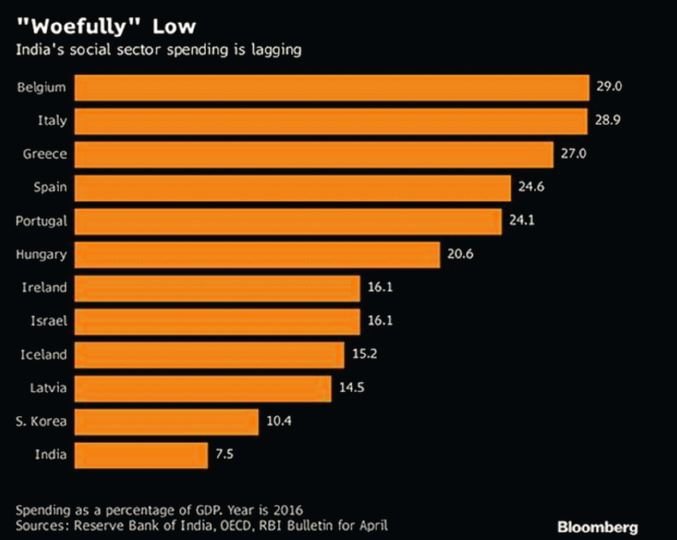

In the aftermath of the extended World War (1914 through 1945) and the defeat of Fascism, about one third of humanity had opted for some form of Communism. The Communist Manifesto had become the second most printed book in the world after The Bible. These were worrying times for the global capitalist system. Hunger, poverty and inequality were increasingly pushing people away from capitalism. Collectivisation and five-year planning to boost industrial growth and the promise to provide basic amenities to all were making the communist model reasonably attractive to many. It was then that W.W. Rostow wrote – The Process of Economic Growth (1953), arguing that industrialisation and modernisation followed fixed steps. He expanded this view in The Stages of Economic Growth in 1960, with the following five steps to prosperity: From Traditional Society-to Preconditions for Change-to Take-off-to Drive to Maturity-to the stage of Mass Consumption.
All countries with traits of traditional societies just needed an external stimulus (help from the US). Following these steps, each country could eventually become prosperous without having to embrace dictatorship under Communism, Rostow announced.
The Stages of Economic Growth became the third most printed book of all times, with A Non-Communist Manifesto1 as its subtitle. And, we should also mention, the CIA had generously sponsored Rostow’s scholarship. As a staff member in President John F. Kennedy’s administration, Rostow in fact promoted his development model as part of US foreign policy.
History has demonstrated, time and again, that the stage-theory of economic growth has not worked; it has many flaws, including not accounting for historical advantages cornered by American and European forces through colonialism, slavery, and imperialism. The post-colonial nation-states were reduced largely as suppliers of raw materials and consumers of goods manufactured in the First World. The traction that communism had in its early years was also gradually eroding, as people resisted having to continuously exchange freedom of thoughts and expressions with a promise of basic amenities and social security – not to mention the fact that it was unable to sustain itself as an economic bloc. The newly emergent nation-states of the Third World were trying to pave a path that could serve its people better. Often, this involved negotiating the Cold War between the First World and the Second World, the two blocs represented by the US and the Soviet Union.
Come the 1990s, and the wave of neo-liberalisation seemed to have engulfed the globe. It brought unprecedented growth and inequality to a number of countries. ‘In India…we [have] had a whopping 2216 percent jump in GDP…with just 0.7 reduction in unemployment rate and extreme poverty remaining unchanged’2 . Over 36 crore people, out of the 1.3 billion total population, survive on Rs 32, in rural India and, Rs 47, in urban India, a day3 . A recent Oxfam report indicated that the 26 richest people on earth in 2018 had the same net worth as the poorest half of the world’s population, i.e., 3.8 billion people. It appears equally depressing in the Indian context with India’s top one percent bagging 73 percent of the country’s wealth. It was 58 percent in 2017, the year before. In fact, in 2018, one billionaire was created every two days. On the other hand, the Non-Performing Assets of all listed banks jumped to Rs 10.25 trillion in the March quarter, from Rs 8.86 trillion in the December 2017 quarter’4.
To complete the contextualisation, it is imperative to remember that the government’s continuous withdrawal from the public welfare space has been a hallmark of liberalisation in India. The RBI described the government’s spending on the health and education sectors in its federal budget as “woefully” below peers’5.
 The fundamental takeaway here is that economic growth does not automatically bring upon economic development. Just to explicate: ‘[e]conomic growth means an increase in output (of services and goods) and is usually measured by the Gross Domestic Product (GDP). On the other hand, economic development refers to the standard of living and economic health of a region, including factors such as human capital, level of education, infrastructure, social inclusion and the quality of healthcare among others. It is usually measured by the Human Development Index (HDI). Economic development is, therefore, a wider concept than economic growth, which is why Amartya Sen argues that “economic growth is one aspect of the process of economic development.”6
The fundamental takeaway here is that economic growth does not automatically bring upon economic development. Just to explicate: ‘[e]conomic growth means an increase in output (of services and goods) and is usually measured by the Gross Domestic Product (GDP). On the other hand, economic development refers to the standard of living and economic health of a region, including factors such as human capital, level of education, infrastructure, social inclusion and the quality of healthcare among others. It is usually measured by the Human Development Index (HDI). Economic development is, therefore, a wider concept than economic growth, which is why Amartya Sen argues that “economic growth is one aspect of the process of economic development.”6
“There is a tremendous amount of sustained growth accompanied by ever rising inequality in the society. Given the information age that we live in, there is an increasing awareness about deprivations and denials, and access to platforms to express one’s opinion, especially, anger and discontent.”
Our discussion on Corporate contribution in sustainable social change is set in this context. There is a tremendous amount of sustained growth accompanied by ever rising inequality in the society. Given the information age that we live in, there is an increasing awareness about deprivations and denials, and access to platforms to express one’s opinion, especially, anger and discontent. This is not the 1950s and ’60s when propaganda rested squarely on the print. There are questions and expectations about the role the rich can play in the democratic process. This is the era when the relationship between political democratic process and its economic benefits is under scrutiny, perhaps more than ever before.
The view that for-profit sector has a significant role to play in addressing societal concerns in India has, therefore, gained momentum of late. It has coincided, of course, with the passing of the Indian Company’s Act in 2013, which mandates that: “…at least 2 percent of the average net profits of the company made during the three immediately preceding financial years” [must be spent] on “Corporate Social Responsibility” CSR) activities. If the company fails to spend this amount on CSR, the board must disclose why in its annual report. The requirement will apply to any company that is inCorporated in India, whether it is domestic or a subsidiary of a foreign company, and which has (i) net worth of Rs 5 billion or more ($83 million), (ii) turnover of Rs 10 billion or more ($160 million), or (iii) net profit of Rs 50 million or more ($830,000) during any of the previous three financial years. This means that about 8,000 companies will spend a combined total of up to Rs 150 billion ($2 billion) annually on CSR activities.”7
However, ‘spending on CSR stood at Rs 7,536.30 crore (around $1 billion) in the financial year that ended in March 2018, according to a survey by KPMG India.’8 ‘If we look at the overall CSR ecosystem in India, the total CSR fund investment by companies in India would cross Rs 50,000 crores by March 31, 2019, since the applicability of the mandatory CSR [2013].’9 Looked in isolation, it may appear as a big amount poured in the development bucket. However, in relation to achieving any of the Sustainable Development Goals, this amount is barely a tiny fraction of the required sum.
 If we move to individual philanthropy, whatever meagre data that exists on the subject, it shows that there is almost no link between the growing wealth in our country and the amount people give via philanthropy. And, left to itself, domestic Indian philanthropy -whether retail or high-value – is unlikely to grow in the manner in which we would hope it to. We know that the philanthropy space has been idiosyncratic in the sense that it depends on the predilection of individual contributors. Smarinita Shetty has produced a highly useful account of the individual philanthropic space’:10 “India has no shortage of billionaires. We added 17 new ones in 2017 alone, taking the count up to 101. During the same year, the wealth of this elite group increased by Rs 20,91,300 crore – an amount equal to total budget of Central Government in 2017-18.”
If we move to individual philanthropy, whatever meagre data that exists on the subject, it shows that there is almost no link between the growing wealth in our country and the amount people give via philanthropy. And, left to itself, domestic Indian philanthropy -whether retail or high-value – is unlikely to grow in the manner in which we would hope it to. We know that the philanthropy space has been idiosyncratic in the sense that it depends on the predilection of individual contributors. Smarinita Shetty has produced a highly useful account of the individual philanthropic space’:10 “India has no shortage of billionaires. We added 17 new ones in 2017 alone, taking the count up to 101. During the same year, the wealth of this elite group increased by Rs 20,91,300 crore – an amount equal to total budget of Central Government in 2017-18.”
There is another list that tracks how the rich have fared in India year after year – the Hurun India Rich List which looks at people with a wealth of over Rs 1,000 crore. In 2018, 831 individuals made it to this list – a 35 percent increase from last year and a jump of 100 percent since 2016. The average wealth on the 2018 list was around Rs 5,900 crores. When it came to philanthropy though, only 38 men and one woman made it to their annual Hurun Indian Philanthropy List 2018, which looks at Indians who have donated Rs 10 crore or more in a 12-month period. Mukesh Ambani who topped the India Rich List with a net worth of Rs 3,71,000 crore was ranked number one on the Philanthropy List as well, having donated Rs 437 crore towards education, healthcare, and rural development; the amount donated equals 0.1percent of his wealth. This is also the first year Mr. Ambani has made it to the top of the Philanthropy List despite having topped the Rich List for the seventh year running. While the number of Indians giving more than Rs 10 crore during the year rose from 27 in 2016 to 39 in 2018, the average donation size actually reduced from Rs. 86 crore to Rs 40 crore.’
‘India’s super wealthy households, or those with a net worth of over $50 million in India, are expected to double in both volume and wealth from 160,600 households with a total networth of Rs 1.53 trillion in 2017, to 330,400 households with a combined net worth of Rs 3.52 trillion in 2022. Buta vast majority of them inherit their wealth and prefer to leave their money to family’.11
The concern with the volume of the contribution, however, may be a small one with regard to Corporate giving; there is apparently a belief that this will gradually improve. According to a study by CSRBOX and NGOBOX, the Corporate spend is expected to touch about 98 percent of the estimated contribution by the end of 2019-20 (Fernandes, cited above). But, surprisingly, this is all what that often gets discussed, both in the Corporate and the not-for-profit sectors.
There are two rather major concerns, which are often missing from the discussions on the CSR.
The first relates to the social part of the CSR. The most obvious question here is what exactly are the social responsibilities of a Corporate? How do they even up to this magical figure of the legislated two percent? This question has a far deeper ethical political meaning than what we often acknowledge. Peter Drucker, perhaps more than any other influential thought leader on management wrote expansively on what he termed “The Age of Social Transformation” which identified the growing potential and creativity of both non-profit and for-profit private sector organisations.
 Drucker differentiated between two types of Corporate social responsibility: those having to do with social impacts or what business does to society and those having to do with social problems or what business can do for society.12 The operational responsibilities (how a Corporate does its business: what sensitivities are shown towards labour and environmental laws, affirmative actions with regard to gender, disability, and social backwardness or human rights in general, for instance) cannot be discounted of no matter how significantly the social responsibilities (things that companies can do for communities and individuals in need) are cast. The overall corporate responsibility is far greater than just its social responsibility, which, then, is reduced to sharing two percent of its profit. So, for instance, should one juxtapose the total CSR contribution to the social development, i.e., Rs 50,000 crores in the last four years, with, say, the total declared Non-Performing Assets? As of March 31, 2018, according to an estimate, the total volume of gross NPAs in the Indian economy stands at Rs 10.35 lakh crore. About 85 percent of these NPAs are from loans and advances of public sector banks13. Many would probably argue that most NPAs are unavoidable business misfortunes, and not a deliberate attempt to syphon off money from public banks, unlike the popular perception. Be that as it may; most of these entities, however, would have generous suggestions for the NGOs about why and how they mustrun their interventions for change effectively.
Drucker differentiated between two types of Corporate social responsibility: those having to do with social impacts or what business does to society and those having to do with social problems or what business can do for society.12 The operational responsibilities (how a Corporate does its business: what sensitivities are shown towards labour and environmental laws, affirmative actions with regard to gender, disability, and social backwardness or human rights in general, for instance) cannot be discounted of no matter how significantly the social responsibilities (things that companies can do for communities and individuals in need) are cast. The overall corporate responsibility is far greater than just its social responsibility, which, then, is reduced to sharing two percent of its profit. So, for instance, should one juxtapose the total CSR contribution to the social development, i.e., Rs 50,000 crores in the last four years, with, say, the total declared Non-Performing Assets? As of March 31, 2018, according to an estimate, the total volume of gross NPAs in the Indian economy stands at Rs 10.35 lakh crore. About 85 percent of these NPAs are from loans and advances of public sector banks13. Many would probably argue that most NPAs are unavoidable business misfortunes, and not a deliberate attempt to syphon off money from public banks, unlike the popular perception. Be that as it may; most of these entities, however, would have generous suggestions for the NGOs about why and how they mustrun their interventions for change effectively.
“One of the leading concerns about their decision to support a social cause is that the corporates in general do not prefer complex and long interventions. This manifests itself in Corporates expressing a special preference for non-profit organisations with single-threaded, mono-thematic focus. A holistic intervention, which is more likely to result in sustainable change often falls short in winning their trust and support.”
The second concern is about Corporates’ understanding of, and commitment to, social change per se. Typically, social change is a complex inter-generational process. It invariably includes changes at: personal (behaviour and practice), social (values and social relations) and systemic (policy) levels. It engages with four elements of everyday life: the individual and her family, the community, the government, and the market . How many Corporate engagements do we know of where all these elements are touched upon? Probably very few. In fact, one of the leading concerns about their decision to support a social cause is that the Corporates in general do not prefer complex and long interventions. This manifests itself in Corporates expressing a special preference for non-profit organisations with single threaded, mono-thematic focus. A holistic intervention, which is more likely to result in sustainable change often falls short in winning their trust and support. For instance, organisations just focussing on Severely Acute Malnutrition are more likely to attract Corporate support than say, those working on Malnutrition. Those seeking to improve overall community health are even far behind in the Corporate pecking order.
We, however, know that social change is a complex beast, and cannot really be realised unless we are willing to engage with the complexities associated with it. It’s not linear like the realities in the Corporate world: Manufacturing-branding – advertising- sales – profit/loss. Repeat.
It is their lack of comfort with complexity that pushes them to embrace simple solutions. The simple, often tech-based, solutions are important contributions, as often they enrich a process of social change, but on their own, they must just be the tip of the iceberg of social change.
This informs the length and depth of a Corporate’s investment in a social change process. They stay invested in a simple intervention with a tangible outcome. There seems to have emerged a pattern among Corporates to support a non-profit endeavour for two to three years and not any longer. Actors in the social development space often wonder if it is possible to achieve social change in a two/three-year project cycle. Then, the support is often about a part of the overall intervention pre-determined by the Corporates understanding and predilections. There seems to be a reluctance to look at and engage with the larger picture that would have allowed for structural corrections, which in turn would have resulted in sustainable change. One reason why many Corporates tend to focus on the palliative, symptoms, rather than the root causes would be that it has the potential to become political, and therefore controversial.
This prompts us to raise a fundamental question: do the Corporates see social change as their mandate? The non-profit sector engages with ‘social change’, ‘development’ and, ‘charity for immediate relief’ – these are three distinct ways of organising one’s work in the social development space. To illustrate: The civil society campaign that resulted in passing of the Right to Education Act is an example of social change. The successful implementation of skilling programmes, resulting in jobs for many young people is an example of development. The distribution of relief material in the wake of a disaster is an example of a charity for immediate relief (ibid).

A study to examine how many Corporates choose to support which of these interventions – change, development, or relief – is worth undertaking.
How do we make a deeper, socio philosophical sense of the choices Corporates tend to make? There seems to be two possibilities. First, we learn that the Corporates’ world-view is still located in the age-old daan parampara, where the givers’ energy is focused on themselves. Gifting remains unequivocally about the giver. There is perhaps little consideration of agency or rights of the deprived and marginalised. Secondly, their penchant for relief and service provision is inextricably tied with their view on the tangibility of a result, which is fashioned by their insistence on evidence on the one hand and instant gratification on the other. Many non-profits, especially those with social entitlements framework, struggle with this dilemma of Relief and Rights. Relief is not always a bad thing though. In any moment of severe crisis or calamity, the relief is also a right. However, in the Corporate circle of givers, rights-based work or efforts at realising social justice in general are considered political and therefore controversial. This pretty much writes off most of the human rights related non-profits.
Partly the perception of our freedom movement, a huge social justice movement in itself too is to be blamed for this. There is little information, especially in the public sphere, about how, for instance, the Congress-led Non-Cooperation Movement, Civil Disobedience Movement and the Quit India Movement were financed. The private papers available in Nehru Memorial Museum and Library now tell us the role played by supportive Corporates like Birla, Dalmia, Bajaj, among others. In the public imagery, this great social justice movement was carried out by near-naked fakirs and mahatmas, selfless leaders and their poor, devoted, followers. Little wonder then, that till date, the expectation is that the NGOs, especially those with the rights lens, often labelled as ‘the activists type asking for human rights and social justice’, will somehow carry on with their commitment, that money does mean much to them.15 Of course, this is for those Corporates who think it is alright to support individuals and organisations devoted to social justice and human rights.
The other reason why, in the ecosystem, we find willing capital for charity (delivering a service) but severe reluctance towards supporting empowerment, is also linked with not just the political culture and history, but also the entire business environment. Why economic growth is not translating into economic development, for example, will remain a taboo question in such a milieu. Peter Karoff sums it of succinctly: ‘The value added for Corporate philanthropy defined in the broadest terms-is not frosting on the cake of goodness; it’s meeting squarely those aspects that are most troubling.’ And globally the wind is blowing favourably.
At the 2007 World Economic Forum in Davos, Richard Parsons, then Chair and CEO of Time Warner, said this: “It isn’t a question of corporations acting in a socially responsible manner. The reality is that we – multinational companies – have no choice but to own the situation. Nation states cannot do it alone.”16
So, how does the landscape look today? Will Rostow have a rebirth?
Well, to begin with, Corporate donations of Rs 10 crore and above have declined by four percent in India since 2014.17 This is when the number of UHNWI households, those with a net worth of over $50 million, has grown by 12 percent during the same period. If we look at India’s commitment to Sustainable Development Goals (SDGs), Bain and Co.’s India Philanthropy Report 2019 estimates suggest that India needs about Rs 26 trillion in annual funding to fulfil even five of the SDGs by 2030 (zero hunger, good health, quality education, gender equality, and clean water and sanitation). “Even in the most optimistic scenario – in which India sustains its current economic growth rate and its current funding growth rate, all philanthropic capital is channelled towards the SDGs, there is no leakage in deployment, and the funding required to meet the SDGs doesn’t increase—the nation will still face an annual funding gap of around Rs 4.2 trillion” (ibid). The question to ponder over, therefore, is: is it possible without the pro-active support of the government? Nation-states may not be able to do it alone, but, can the Corporates fill in the gap left by the withdrawal of the State? If the landscape has to change quickly, who will show the way?
 And that’s where one can see a glimmer of hope. Today, there is a much greater awareness that things do not improve on their own, that there is no way to ensure that the prosperity of the few will automatically, gradually, permeate to all. If anything, there is more robust evidence that with growth in the GDP, without conscious efforts at development of all, only inequality grows. Certain Corporates and individual philanthropists have begun to push the envelope of engagement with social issues for others to feel inspired, and follow. Azim Premji Philanthropic Initiatives Pvt. Ltd leads the way. It accounts for more than 80 percent of total contributions made by individual philanthropists contributing over Rs 10 crore a year. Apart from the volume of contribution, which is huge, it is its nature and direction that is commendable. There seems to be a concerted effort to take ‘philanthropy for impact’ to a new level. What is equally reassuring is that some Corporate individuals and houses have begun to see the significance of the development sector work in a more strategic way, leading them to invest in capacitating the sector itself.18 Both, together, hint at a departure from the traditional framework of random giving where the energy was derived from religion and the agency solely rested with the Giver.
And that’s where one can see a glimmer of hope. Today, there is a much greater awareness that things do not improve on their own, that there is no way to ensure that the prosperity of the few will automatically, gradually, permeate to all. If anything, there is more robust evidence that with growth in the GDP, without conscious efforts at development of all, only inequality grows. Certain Corporates and individual philanthropists have begun to push the envelope of engagement with social issues for others to feel inspired, and follow. Azim Premji Philanthropic Initiatives Pvt. Ltd leads the way. It accounts for more than 80 percent of total contributions made by individual philanthropists contributing over Rs 10 crore a year. Apart from the volume of contribution, which is huge, it is its nature and direction that is commendable. There seems to be a concerted effort to take ‘philanthropy for impact’ to a new level. What is equally reassuring is that some Corporate individuals and houses have begun to see the significance of the development sector work in a more strategic way, leading them to invest in capacitating the sector itself.18 Both, together, hint at a departure from the traditional framework of random giving where the energy was derived from religion and the agency solely rested with the Giver.
There is a growing realisation to engage all the stakeholders – underserved people, non-profits, Corporates, and the government – for an effective and sustainable solution to social problems. Given the giant scale of problems India has, sure enough, the beginning looks quite modest. What is heartening is, there is a beginning.
Dr. Arun Kumar is the CEO of Apnalaya. He has worked with both implementing and support organisations in his career with nonprofits, spanning more than twenty years.
Drawing from the best of many worlds, having grown up in rural Bihar and being educated in Delhi and New York, Arun supports evidence-based advocacy with the government for a citizen-driven process of social change. He has authored three books and several articles on history and sociology in national and international journals.
The thoughts and opinions expressed in the text here belong solely to the author, and not necessarily to his employer or organisation.
He can be reached at:arunkumar3165@gmail.com

